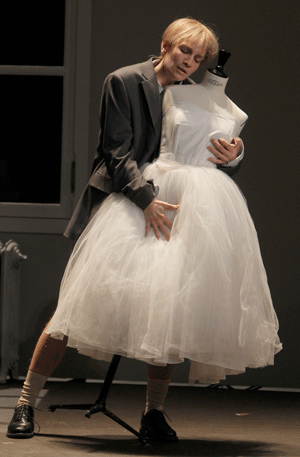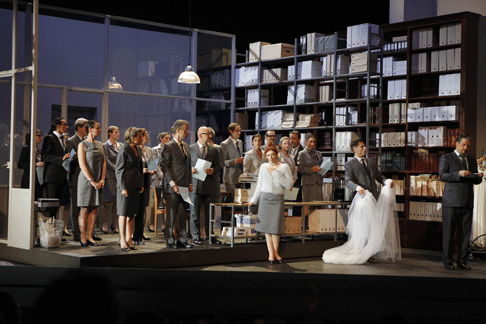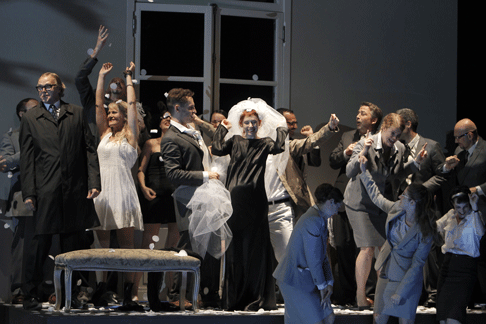18 Jul 2012
Le Nozze di Figaro in Aix-en-Provence
You pay your money, you takes your chances — that is festival life at its best. Sometimes it pays off and sometimes it doesn’t. The fun is in the risk, so the riskier the better.

You pay your money, you takes your chances — that is festival life at its best. Sometimes it pays off and sometimes it doesn’t. The fun is in the risk, so the riskier the better.
Yes, it was risky indeed for the Festival’s umpteenth production of Le Nozze di Figaro by the Festival’s signature composer, W.A. Mozart (that’s Mose-art in French by the way). Richard Brunel, director of the Comédie de Valence (a small city south of Lyon), re-conceived Beaumarchais’ testy little comedy to take place in a contemporary notaire’s office, or maybe it was an avocat’s office or some sort of corporate office where Barbarina was the receptionist (it was confusing), with grand doors embedded into the stage left wall leading into, we later learned, a large room with two sewing machines.
 Kate Lindsey as Cherubino
Kate Lindsey as Cherubino
It seems that there was to be an office wedding with Susanna and Marcellina arguing who was going to wear the wedding veil (Via, resti servita), a long white filmy thing that was on stage most of the opera. The count, who was a lawyer or something, sometimes brought his dog to the office as if he had just been hunting and still had his gun with him. His dog was really smart and sniffed out the door behind which Cherubino was hiding and guarded it while the Count, strangely lacking janitorial staff, went to get some tools. Later when things got out-of-hand between the Count and Countess the dog barked in just the right place, the only moment he could get a bark in.
A court room appeared on stage right, abutting the count’s office. Everyone soon gathered for various reasons and then the Countess wandered in too and sang her Dove sono (translation: Where am I?). In the end the Countess wore a wedding gown to disguise herself as Susanna, and Susanna wore black with a high grey turban to hide the Countess’ long blond hair (we had been amazed earlier by this strange coiffure on the Countess ). The sterile (no plants) garden seemed to be behind some featureless house in a French banlieue (suburb) parts of which kept sliding eerily about the stage making everyone even sleepier (it was 1:30 AM by then).
 Patricia Petibon as Susanna, Kyle Ketelsen as Figaro and Paolo Szot as the Count
Patricia Petibon as Susanna, Kyle Ketelsen as Figaro and Paolo Szot as the Count
The curtain fell (well, a large flat thing slowly descended) and when it rose for the artists to take their bows the star of the show appeared alone on the stage. Yes! The dog.
Some very good singers then made their way onto the stage to accept applause. Figaro, American baritone Kyle Ketelson, of course had the final bow. Mr. Ketelsen had a huge success two years ago in Aix as Don Giovanni’s cheeky sidekick, a very physical Leporello. He is a vivid performer who projects text to perfection but dressed in a suit and tie his cheek did not find character in Figaro. The biggest ovation went to Cherubino, American mezzo Kate Lindsay, dressed in a suit and tie who fussed with the Countess’ bra (the libretto says ribbon) and sang breathlessly making Mozart’s young lover quite fun and real.
Brazilian baritone Paolo Szot who was to have appeared in Aix’s Nose but did not was the Count. Mr. Szot has a quite beautiful voice, beautifully used. He is often strangely type miscast in big houses (because he is South American i.e. latin) as Escamillo in spite of a soft, pretty presence. He did not read as a bonafide sexual predator, and made Almaviva seem even sympathetic and misunderstood in his garden escapade.
 John Graham-Hall as Basilio, Mari Eriksmoen as Barbarina, Kyle Ketelsen as Figaro and Patricia Petibon as Susanna
John Graham-Hall as Basilio, Mari Eriksmoen as Barbarina, Kyle Ketelsen as Figaro and Patricia Petibon as Susanna
These were the big house singers. Things got risky with French soprano Patricia Petibon as Susanna and Swedish soprano Malin Byström as the Countess. Mlle. Petibon gave Susanna a quite saucy “ina” (Zerlina, Despina) character in a quite smokey voice that precluded any text projection. At first it seemed Mlle. Byström might be a Swedish dramatic soprano in training, but it became apparent that she is a lovely, quite beautiful singer who does not project strong character. Both women boast important credits in early music so perhaps the attributes that made their performances pale on the Archevêché stage are valuable in other circumstances. The singers in the supporting character roles were swallowed up in the concept.
The evening’s conceit seems to have been to juxtapose hard edge contemporary dramaturgy and design with real, old, decorative music, a conceit that in some circumstances might spawn better results. The risky orchestra in Aix was Le Cercle de l’Harmonie, a group based in Deauville (Normandy) led by violinist/conductor Jérémie Rhorer, a protégé of William Christie. This orchestra has been specifically built to perform the music of the late 18th century (i.e. Mozart and Hadyn). As it was from row M in the Archevêché the music seemed long ago and far away, a bit like an old reed organ without sufficient air supply. Conductor Rhorer’s tempi seemed appropriate for the occasion.
Maybe you had to be French.
Michael Milenski